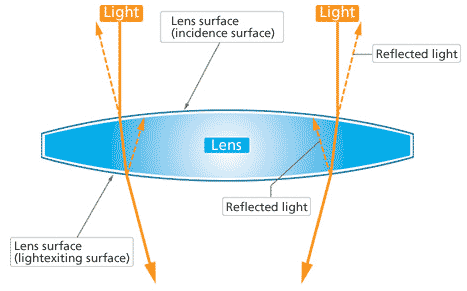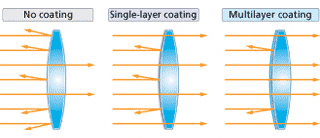Anti-Reflection Lens Coatings on Binoculars
In binoculars, anti-reflection coatings are mainly designed to assist with light transmission thus helping to produce a brighter image with better contrast. These days almost all good quality binoculars some sort of these coatings applied to at least some of the air to glass surfaces of their lenses.
These anti-reflection coatings are often made up of a number of very thin, transparent film layers, each having a distinct index of refraction which alters the lens’s performance with different wavelengths and at different incident angles.
Because of this, color effects often appear at oblique angles and so you can sometimes see these coatings as they are usually what produces the blue, red, or green reflections you see when you look into the front of a binocular’s objective lens at different angles.

Improved Transmittance and Image Brightness
In any lens, some of the light that passes through the lens is reflected by the front (incident light) and rear (exiting light) surfaces. This reflection reduces the amount of light passing right through the lens and thus to your eyes.
If the amount of light reflected away is very bad, the image you see when you look through the binoculars will be darker than on binoculars that transmit more light.
As well as producing a less bright image, reflected light may cause ghosting, flares and also affect the contrast of the image.
So during the manufacturing process, these special anti-reflective coatings are added to the lenses on better quality binoculars, which drastically decreases the amount of surface reflection losses and can significantly increase the transmittance of light to ensure you get as bright, clear and sharp image as possible.
Ghost Imaging
What is more, the undesirable secondary reflections that can interfere with the transmitted image, producing what is known as “ghost imaging” can also be all but completely be eradicated using good anti-reflection coatings.
More Benefits:
Because the amount of reflection from the lenses is reduced, these coatings also help in that they reduce the glint coming off the lenses. This is important if the user of the binoculars does not want to give away their position. Important for military, law enforcement, hunting and even general wildlife observation applications.
Coated vs Multi-Coated vs Fully Multi-Coated
 When researching a binocular, it is important to note how the manufacturer describes their coatings:
When researching a binocular, it is important to note how the manufacturer describes their coatings:
Coated – means a single layer antireflection coating on some lens elements, usually the first and last elements (the only ones you can see).
Fully Coated – means that all air to glass surfaces are coated, which is obviously an improvement on a single layer coating.
Multi-Coated – means that at least some surfaces (again, usually the first and the last) have multiple layers of antireflection coatings. (A multilayer coating effectively reduces reflected light that cannot be eliminated with a single-layer coating, and increases the transmittance of light.) Multiple layers are about an order of magnitude more effective than a single layer.
Fully Multi-Coated – means that all air to glass surfaces have received multiple layers of anti-reflection coatings – this is what you want in your binoculars.
The table below shows Transmittance by type of coating:
| Per Single Lens Surface | 10 Lens & Prism Surfaces | |
| No Coating: | 96% | (0.96) x Power of 10 = 0.66 66% |
| Single-Layer: | 98.5% | (0.985) x Power of 10 = 0.86 86% |
| Multilayer Coating: | 99.5% | (0.995) x Power of 10 = 0.95 95% |
Cost of Fully Multi-Coated Binoculars
There was a time when you would only find fully multi-coated binoculars at the top end of the market. But as production methods improved and because of the influence of the cheaper production costs from mostly Asian manufacturers, more and more binoculars were being fully multi-coated.
So because of this increased competition and better manufacturing techniques, most mid range and even some low cost binoculars come fully multi-coated with anti-reflection coatings. So now a bin needs far more optical features, like for example the use of ED Glass in their lenses, to even have a chance of standing out from the crowd.
Best Value Fully Multi-Coated Bins
So to help with this and to help seperate the wheat from the chaff, below I have listed a few of what I consider to be some of the best value for money fully-multi-coated binoculars around:
| Low Cost |
Mid Priced | Mid-High | High End |
| $50 – $130 / £50 – £130 |
$130 – $300 / £130 – £300 |
$300 – $500 / £300 – £500 |
$500-$1200 / £500-£1200 |
 Pentax Papilio II 8.5x21 |
 Hawke Frontier HD X 8x42 |
 GPO Passion ED 8x42 Binoculars |
 Maven B1.2 10x42 Binoculars |
More: View all Best Value Binoculars I have reviewed.
How the Coatings are Applied
Many optical manufacturers use mineral pellets that are then evaporated into microscopic particles which then coat the lenses. For more on this process, take a look at this article and video on How Binoculars are Made.
A Note on “Ruby Coatings”
There are some binoculars that advertise that they have ruby or red multi-coatings. These are intended to reduce glare in bright light, or enhance specific colors in specific environments and has had some limited success in very specific applications.
But due to the fact that it “looked cool”, many low-end binocular producers started making ruby coated binoculars to filter red to compensate for their poor-quality optics that do not properly converge the color spectrum. For more: Ruby Coated Binoculars.

 Article | Posted by Best Binocular Reviews
Article | Posted by Best Binocular Reviews 
 Categories:
Categories:  Tags:
Tags: 

the very same for photography lenses and filters. Din’t know the exact meaning till now. Thanks. In spanish: “multi-capa”.
Most welcome – glad to help & thanks for the Spanish translation